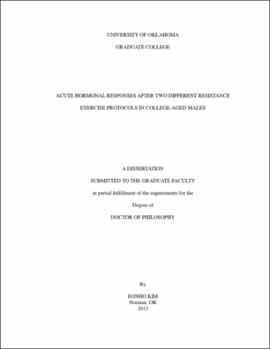| dc.contributor.advisor | Bemben, Michael | |
| dc.creator | Kim, Eonho | |
| dc.date.accessioned | 2019-05-01T17:22:29Z | |
| dc.date.available | 2019-05-01T17:22:29Z | |
| dc.date.issued | 2013 | |
| dc.identifier | 99106487702042 | |
| dc.identifier.uri | https://hdl.handle.net/11244/319380 | |
| dc.description.abstract | PURPOSE: The purpose of the current study was to compare the acute hormonal responses of two resistance training exercise protocols (Traditional and SuperSlow) that had similar exercise volumes but differed in intensity and contraction speeds in college-aged males. | |
| dc.description.abstract | METHODS: Thirteen healthy college-aged male subjects participated in this study. This study was a randomized cross-over design. All participants performed a session of low intensity resistance exercise (50% 1-RM) with slow velocity contractions and a session of traditional high intensity resistance exercise (80% 1-RM) separated by 3weeks. Participants in both exercise conditions performed four upper body (shoulder press, biceps curl, chest press, low row) and four lower body (knee extension, knee flexion, two-leg press, calf raises) exercises. The contraction velocities were either slow speed contraction (10 seconds concentric and 5 seconds eccentric) for low intensity resistance exercise or normal speed contraction (1.5 seconds concentric and 1.5 seconds eccentric) for high intensity resistance exercise. Pre, immediate post exercise, and 15 minutes post exercise blood samples were taken to determine CK, cortisol (COR), and testosterone (TES) concentrations. | |
| dc.description.abstract | RESULTS: Two-way (condition × time) repeated measures analysis of variance (ANOVA) revealed no significant main effects for condition or time and no significant condition × time interaction for CK ( p = 0.121, p = 0.286 and p = 0.992, respectively). Repeated measures ANOVA revealed a significant main effect for time for TES (p = 0.012) and COR (p = 0.009) but no significant main effect for condition and no significant condition × time interaction (TES: p = 0.614, p = 0.509, COR: p = 0.452, p = 0.710 respectively). Both significant main effects for time for both TES and COR were no longer significant when hormone values were adjusted to account for changes in plasma volume. There was a significant main effect for time for LA (p = 0.000) from pre to post exercise time points. | |
| dc.description.abstract | CONCLUSION: The hormonal responses for the low intensity, slow contraction speed, SS condition and the high intensity, normal contraction speed, TR condition were similar even though the SS condition had fewer sets and repetition compared to the TR condition. | |
| dc.format.extent | 151 pages | |
| dc.format.medium | application.pdf | |
| dc.language | en_US | |
| dc.relation.requires | Adobe Acrobat Reader | |
| dc.subject | Exercise--Physiological aspects | |
| dc.subject | Exercise for men | |
| dc.subject | Isometric exercise | |
| dc.subject | Hormones | |
| dc.subject | Creatine kinase | |
| dc.subject | Hydrocortisone | |
| dc.subject | Testosterone | |
| dc.title | Acute hormonal responses after two different exercise protocols in college aged males | |
| dc.type | text | |
| dc.type | document | |
| dc.thesis.degree | Ph.D. | |
| ou.group | College of Arts and Sciences::Department of Health and Exercise Science | |
